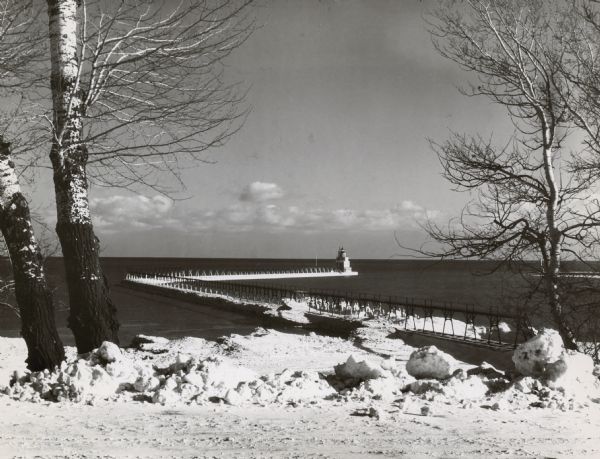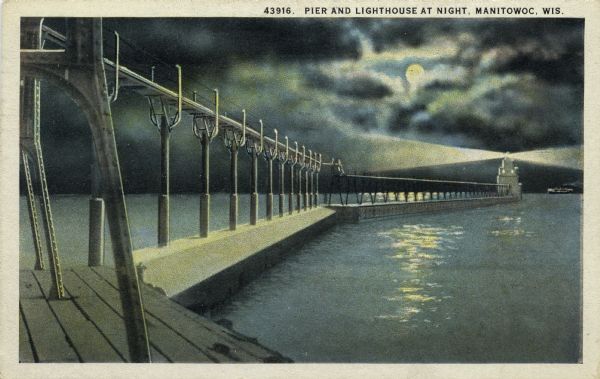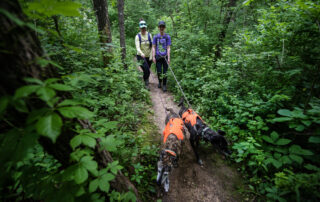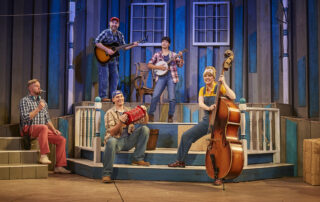On the western coast of Lake Michigan sits the city of Manitowoc, Wisconsin, a place known for its deep connection with the water. And along its shore, a lighthouse essential to the area’s maritime history stands tall, watching over the city. Molly Hunken climbs inside to take us on a tour of the Manitowoc Breakwater Lighthouse. The building is part of the Wisconsin 101 project, which tells the history of Wisconsin through objects.
==

The Manitowoc North Breakwater Lighthouse sits about a mile out from the city’s shore. Its position perched on a structure called a breakwater prevents large waves from reaching docking boats. (Molly Hunken/WPR)
The Manitowoc North Breakwater Lighthouse stands about half a mile off the shore of Lake Michigan. It was built in 1918, making it over 100 years old. Its name comes from the structure that it’s built on.
“When you walked out here, on the concrete, that’s the breakwater. It separates the lake from the harbor, and it makes a safe place for the ships to come in and be protected,” said Paul Roekle, a member of Manitowoc Sunrise Rotary Club. The organization hosts fundraisers for the community and has also become the official caretakers of the lighthouse.
The building itself has five stories.
Its first floor is a basement, which used to act as storage and a boathouse. This portion of the basement housed a dory, a small boat which lighthouse keepers used for rescues.
“You can read stories on it where the lighthouse keepers would take care of the rescues on the lake when they occurred,” Roekle explained. “Even in the middle of winter … a tremendous blizzard, at night, no lights. They had to listen to the sounds and actually push the boat out, hop in it and go out and rescue the people and bring it back in. It wasn’t just that they maintained the lighthouse, but they took care of the lakes in this area too.”

The motor room used to be home to the 25 horsepower Fairbanks Type-Z engine which ran the power for the whole lighthouse. Today, power comes from a cable which runs underwater from the building to the shore, while the light is powered by solar panels. (Molly Hunken/WPR)
On the second floor, the Motor Room housed the motor to generate power for the light on top.
Above that on the third floor sat the Watch Room where lighthouse keepers used radio equipment to contact boats on the lake. In cases of stormy weather, lighthouse keepers sometimes stayed overnight in cots in this room, though they normally slept in designated apartments on shore.
The Diaphone Room on the fourth floor used to be the location of the foghorn, also called a diaphone. Ships could activate the diaphone from the lake to warn of their arrival on shore.
From the deck outside, you can often see the S.S. Badger Car Ferry, which has been running since the 1950s, beginning its round trip between Manitowoc and Ludington, Michigan. As the ferry passes the lighthouse, bystanders can hear the honk of the boat as well as shouting between ferry passengers and those at the lighthouse.
After a brief climb up a small metal ladder, you reach what most people would think of when imaging a lighthouse: the Lens House or Lens Room.

The small lens house on top of the lighthouse currently holds a light less complicated than the lighthouse’s original lens, which currently resides in the Wisconsin Maritime Museum. The light can be seen from 17 miles out in the lake, and helps guide ships to shore. (Molly Hunken/WPR)
“That’s the main part of the lighthouse. That’s where the light that signals to the ships is located,” said Roekle. “This particular light could be seen from 17 miles out in the lake, which is by no means all the way across the lake or anything, but it was 17 miles that they could get visibility.”

From the top of the lighthouse, much of the city of Manitowoc is visible. This includes the apartments where the lighthouse’s original keepers lived while not on a shift. (Molly Hunken/WPR)
The small room on top of the lighthouse holds no more than the light itself, with enough space for a few people around it. The original Fresnel lens, made of hundreds of pieces of glass, is currently being restored with plans to display it in the Wisconsin Maritime Museum, also located in Manitowoc. The current light is powered by solar panels located outside the Diaphone Room.
The expansive view from the top of the lighthouse looks out over Lake Michigan and the city of Manitowoc, including the apartments where the lighthouse keepers lived up until the installation of solar panels to automate the lighthouse in the 1970s.
After the need for lighthouse keepers disappeared, the building became run down. Roekle said it succumbed to vandalism and the wear and tear expected for a building in the middle of a lake.

A photograph on display inside the Manitowoc Breakwater Lighthouse shows the watch room and Chester V. Marshall, the last keeper of the lighthouse before it was automated in the 1970s. (Molly Hunken/WPR)
However, after the passing of the National Historic Lighthouse Preservation Act in 2000, the U.S. Coast Guard began auctioning off lighthouses deemed unnecessary due to modern GPS systems to interested buyers. In 2011, the Manitowoc Breakwater Lighthouse was one such lighthouse. It was purchased by Long Island, New York resident Philip Carlucci for $30,000. Roekle said he thinks it’s a pretty good deal for a five story building.
“The only problem is there’s some policies that go along with it,” Roekle said. “When you buy a property from the Coast Guard, you have to bring it up to standards and maintain it. So, (Carlucci) stuck over $325,000 into it to get it in the condition it is in today.”
According to Roekle, repairs made to the lighthouse so far have included new windows and doors, fresh paint jobs, and fixing up any remaining damage.

Paul Roekle is a member of Manitowoc Sunrise Rotary, a club which is in charge of maintaining the Manitowoc North Breakwater Lighthouse. Members like Roekle give guided tours of the lighthouse by request, and work closely with the lighthouse’s owner to restore the building. (Molly Hunken/WPR)
While most people may not know that a market exists for those interested in buying lighthouses, Roekle said Carlucci has his reasons for purchasing the Manitowoc North Breakwater Lighthouse.
“Someone asked him one time, ‘What do you want a lighthouse for?’” Roekle remembered. “His answer was, ‘Don’t you think everybody would like a lighthouse if they could?’ I always tell people, people collect a lot of things: cars, thimbles, matchbooks, whatever you know. Some people collect lighthouses.”
Carlucci and Manitowoc Sunrise Rotary Club are collaborating with the Wisconsin Maritime Museum to return historical objects and equipment to the building. Looking forward, the owner hopes to continue restoring the lighthouse to its original state.

The Manitowoc Breakwater Lighthouse entered service in 1918, was automated in 1971 and sold in 2009. The lighthouse is located on the end of a 400 foot breakwater. Snow and trees are along the Lake Michigan shoreline in the foreground. This photo was taken in 1951. (Courtesy of Wisconsin Historical Society)
==
MUSIC: “The Lighthouse’s Tale” by Nickel Creek








